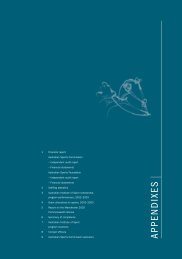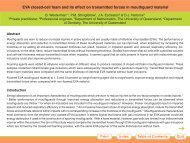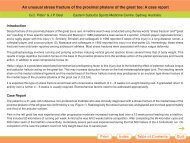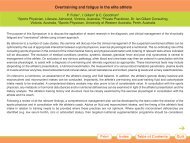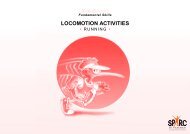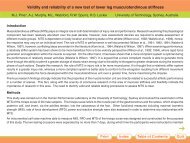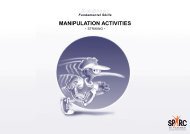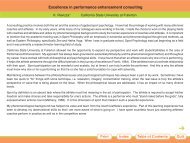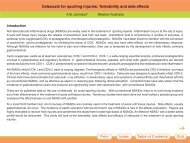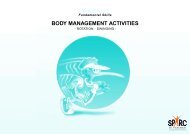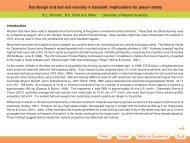2002-03 Annual R eport 2002-03 Annual R eport - Australian Sports ...
2002-03 Annual R eport 2002-03 Annual R eport - Australian Sports ...
2002-03 Annual R eport 2002-03 Annual R eport - Australian Sports ...
You also want an ePaper? Increase the reach of your titles
YUMPU automatically turns print PDFs into web optimized ePapers that Google loves.
ATTRACT, DEVELOP AND KEEP PEOPLE IN THE GAME<br />
Middle & bottom. Part of Cricket<br />
Australia’s Game Development<br />
brief is to extend cricket beyond<br />
its traditional boundaries by<br />
increasing participation<br />
amongst Indigenous<br />
communities.<br />
Aboriginal and Torres Strait Islander cricket<br />
As part of its commitment to extending cricket beyond its traditional boundaries, Cricket Australia has<br />
continued the challenging task of increasing participation in Indigenous communities.<br />
The bulk of the strategy involves exposing cricket to a culture under represented in the game since an<br />
Aboriginal team made the first trip to England in 1868.<br />
Broadly speaking, Indigenous cricket is guided by Cricket Australia’s National Indigenous Advisory<br />
Committee which this year was assisted by a sub-committee in each state and territory.<br />
The committees’ charter is to act as a reference group to provide Cricket Australia and state and<br />
territory associations with information, advice and policy direction on Indigenous cricket matters.<br />
As a result, Cricket Australia is rolling out an Indigenous cricket strategic plan adopted in January<br />
<strong>2002</strong> entitled Two Strong Cultures: Australia’s New Cricket Tradition which identifies a number of ways<br />
cricket can be taken to Aboriginal people.<br />
The plan’s objectives are to:<br />
• increase participation of Aboriginal and Torres Strait Islander people in all areas of cricket;<br />
• educate both Indigenous and non-Indigenous <strong>Australian</strong>s to build knowledge for increased<br />
cricket participation in Aboriginal and Torres Strait Islander communities;<br />
• build an organisational structure and relationship that allows for effective two-way<br />
communication between all stakeholders; and<br />
• provide access to cricket facilities and equipment, appropriate to the needs of Aboriginal and<br />
Torres Strait Islander communities.<br />
The showpiece of the Indigenous program is the annual Prime Minister’s XI v Aboriginal and Torres<br />
Strait Islander Commission (ATSIC) Chairman’s XI match that serves as an opportunity for talented<br />
Indigenous cricketers to display their skills on a national stage.<br />
In 20<strong>03</strong> this match attracted a far greater development focus, with all members of the ATSIC<br />
Chairman’s XI attending a training camp prior to the game at the Commonwealth Bank Cricket<br />
Academy.<br />
The all-Indigenous cricket carnival, the Imparja Cup, is another key plank of the Indigenous program<br />
that sees representative teams from across the nation take part in a four-day tournament in Alice<br />
Springs.<br />
From that tournament, a 16-man development squad was selected, and, from that squad, certain<br />
players joined members of the ATSIC Chairman’s XI to represent an Indigenous team at the State<br />
Institute Challenge in far north Queensland during August 20<strong>03</strong>.<br />
The year also saw the task of making cricket more accessible to Indigenous <strong>Australian</strong>s continue, with<br />
more than 200 junior cricket kits distributed to Aboriginal communities across the nation.<br />
The <strong>Australian</strong> <strong>Sports</strong> Commission’s Indigenous <strong>Sports</strong> Program contributes heavily to these<br />
initiatives.<br />
20



